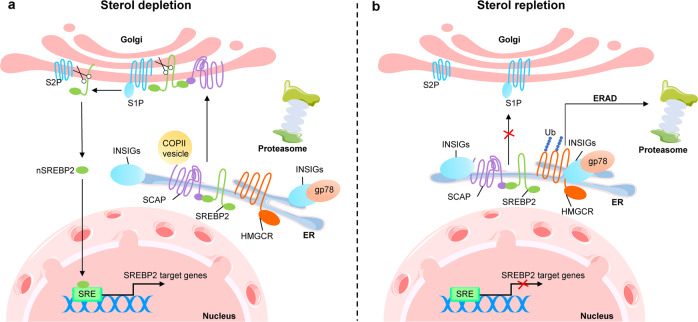Fig. 2.
SREBP2 pathway in regulation of cholesterol biosynthesis. The process of cholesterol biosynthesis is strictly regulated by negative feedback, of which the sterol regulatory element binding protein (SREBP) pathway and the HMG-CoA reductase (HMGCR) degradation pathway are the two main mechanisms of negative feedback regulation. a SREBP2 forms a complex with SREBP cleavage activating protein (SCAP) at the ER. When sterol depletion occurs to cells, SCAP binds to COPII vesicles, allowing the SCAP-SREBP complex to translocate from the ER to the Golgi for cleavage. SREBP2 is sequentially cleaved by S1P and S2P in the Golgi, and the N-terminal of SREBP2 is subsequently transported to the nucleus, where the N-terminal of SREBP2 recognizes and binds to the SRE sequence on the target gene promoter to activate the target gene transcription. In addition, HMGCR is also prevented from binding to INSIGs and gp78 (ubiquitin ligase) during cholesterol depletion, thereby stabilizing HMGCR to activate cholesterol biosynthesis. b When the cell sterol is replete, it triggers the interaction of SCAP with INSIGs, resulting in blocking the binding of SCAP to COPII and keeping the SCAP-SREBP2 complex in the ER. At the same time, HMGCR also binds to INSIGs and gp78, which catalyzes the ubiquitination of HMGCR. The ubiquitinated HMGCR is eventually degraded in the proteasome via ER-related degradation (ERAD). Ub ubiquitin

